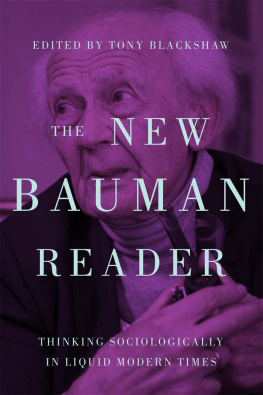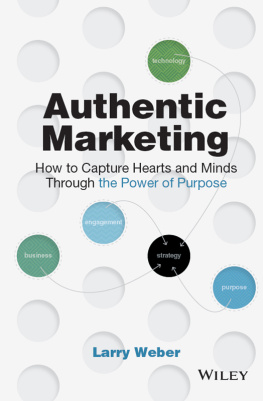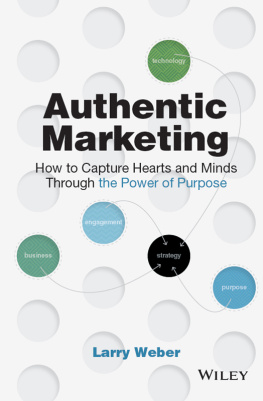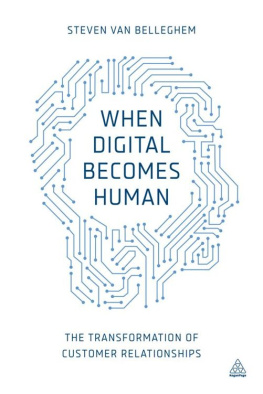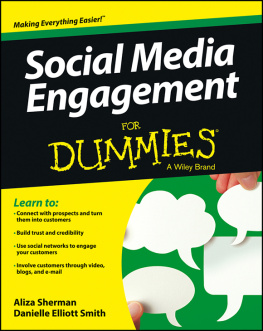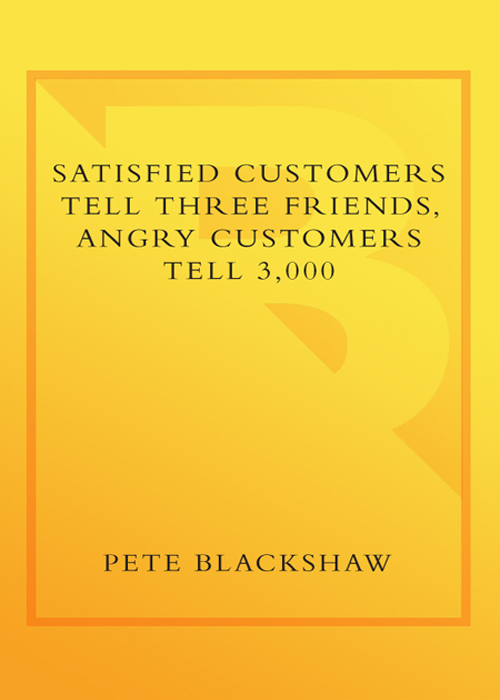
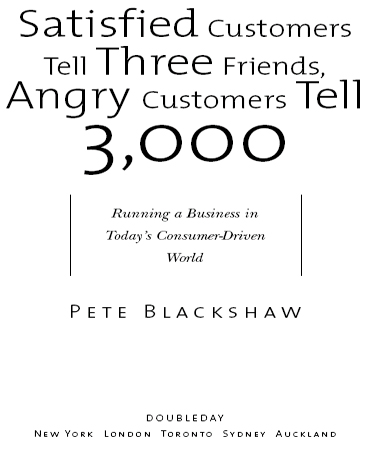
CONTENTS
DEDICATED TO MY FATHER,
WILLIAM J. BLACKSHAW,
AND TO JAMES HESKETT
ACKNOWLEDGMENTS
There are so many individuals who have provided either assistance or inspiration to this project. First, my wife, Erika Brown, has been incredibly supportive and encouraging on so many levels, and I would certainly be remiss not to credit her for the original concept behind PlanetFeedback.com after we had a horrendous airline service experience. Shes also the mother of my three beautiful children, Liam, Leila, and Sophia, a source of constant joy and daily inspiration.
My partners at Lark Productions, Lisa DiMona and Robin Dellabough, have patiently and thoughtfully worked with me on this project since its inception and are absolutely incredible. I also owe huge thanks to Talia Krohn and Roger Scholl of The Doubleday Publishing Group for their enthusiasm and help shaping the key theme and direction of the book. Thanks to others on the Doubleday team as well: Rachel Lapal, Meredith McGinnis, Nicole Dewey, and Rebecca Gardner.
Harvard Business Schools James Heskett, for whom the book is co-dedicated, inspired so much of the thinking in this book. His service-management course at HBS lit the spark of my obsession over the relationship between service and profitability, between listening and loyalty. Moreover, I will always be indebted to him for serving on the boards of PlanetFeedback and Intelliseek, and for always being available for trusted advice and counsel, especially during the tough periods.
The always inspirational Seth Godin deserves credit for the book title, and Id be remiss not to also thank him for being a strong advocate with the venture community when I started my first company out of P&G. Greg Brummer has been invaluable with case studies, consumer interviews, surveys, all-around consumer smarts, and more. Karen Watts played a deeply appreciated early role in getting this project off the ground.
David Dintenfass, friend and P&G Associate Marketing Director, relentlessly pushed me to pursue this project, in particular helping me to think through the Six Drivers of Credibility framework. Other special sources of inspiration include Max Kalehoff and Sue MacDonald, Kelly Mooney, Ted McConnell, Greg Icenhower, Len Ellis, Jay Gooch, Raymond Buse, Laurent Flores, Chris Lansing, Doyle Estevick, Mark Marsan, Dave Evans, Tom Watson, Jeffrey Rayport, Tim Heath, Jon Sviokla, Jan Marie Zwiren, and my brother John Blackshaw. Denis Beausejour, friend, mentor, and former Global VP of Advertising at P&G, deserves credit for drilling into my head that at the end of the day, its all about the consumeralways! The same goes for Robert Wehling, John Pepper, Vivienne Bechtold, Ted Woehrle, and Charlotte Otto. Former Grey Interactive leaders Norm Lehoullier and Orin Wechsberg have provided trusted advice and guidance.
Beth Thomas-Kim, Global Head of Consumer Services at Nestle, and Chairwoman of the Society of Consumer Affairs Professionals, provided thoughtful input and feedback, and no shortage of motivation, as did Tom Asher, Head of Consumer Affairs at Levis. Bruce Ertmann, Toyotas Director of Consumer-Generated Media, has been a tremendous inspiration and help to me, especially on the Defensive Branding Themes. Fred Siff of the University of Cincinnati was one of my very first customers, and his breakthrough work with new technologies continues to awe me. Scott Wilder of Intuit opened up an entirely new perspective on the power of online communities.
In my real job I draw invaluable perspective from so many current and former colleagues: Mike Nazzaro, Jay Stock-well, Betsy Cohen, Becky Hudepohl, Brian Schlessinger, Dan Mechem, Bill Stephenson, Jay Rampuria, Karen Watson, Doug Widmann, Andrew Ferrigno, Jim Savage, Jonathan Carson, Jerry Needel, Kate Niederhoffer, Amy Hatton, Alison Kalis, Lydia Worthington, Jenifer Putalavage, Charlie Buchwalter, Ori Levy, and Manish Bhatia. Mahendra Vora, Sundar Kadayam, Karthik Iyer, Chris Connaughton, Jonathan Schlerer, Matt Hurst, Mark Reed, and Natalie Glance all introduced (and humbled) me to the power and potential of advanced text analytics and unstructured data analysis. Oliver Fisher, Mike Kunz, Jon Mamela, and Louis Goldner were part of the alpha group exploring the power of complaints. And interns Chandler Koglmeier and Chris McConnell introduced me to an entirely new level of understanding about social media.
Other key supporters and investors, now and in the past, include: Jack and Peg Wyant, Bill Hildebolt, Itzhak Fisher, Rick Kieser, John Gardner, Nick Nicholas, Fred Wilson, Jerry Colonna, Rick Lerner, and Ted Dintersmith.
Others have encouraged me to test my themes and hypotheses; among them: Rebecca Lieb and Erin Brenner, my editors at ClickZ, current and former Ad Tech leaders Susan Bratton and Drew Ianni, and Jack Neff of Advertising Age, who has always been a great sounding board and an occasional much appreciated skeptic. And of course Id be remiss not to mention former and current collleagues and current and former board members of the Word-of-Mouth Marketing Association, who walk the talk on so much of what this book is all about: Jim Nail, Ed Keller, Paul Rand, Dave Balter, Rick Murray, Jackie Huba, John Bell, Sam Decker, Leslie Ford, Idil Cakim, Jamie Tedford, Peter Waldheim, Gary Spangler, Andy Sernovitz, Laura Schuler, Julie Wittes Schlack.
Id also be remiss not to thank State Senator Art Torres, a tireless advocate for Californias Hispanic and immigrant community, who represented one of the most diverse districts in the nationfrom Chinatown to East L.A.for teaching me how to listen to less obvious (but ever important) signals in the marketplace. He also empowered me to test new feedback models in the California legislature.
And lets not forget my parents: Jay Blackshaw, for always keeping me grounded in consumer-centered values; and to my dad, Bill Blackshaw, who passed away last year after living a beautiful 83 years, for being so supportive and cultivating a deep appreciation of all that can be good in advertising.
Most important, to all the consumers online, from PlanetFeedback.com and YouTube.com to Facebook and the millions of bloggers out there. Yeah, I know, it sounds hokey, but I lean on you every day for inspiration.
Introduction
D ell Inc. learned a hard lesson in July 2005, when the high-profile blogger and mainstream media pundit Jeff Jarvis had an unhappy experience with a new laptop computer. Angered by Dells feeble and ineffective attempts to help him with his problem, Jarvis decided to vent his frustration by taking the computer giant to task on his blog, BuzzMachine.com. Jarvis used his bloggy pulpit to write an open letter to Dells founder, Michael Dell, challenging the quality of the companys products and customer service, and assaulting its basic value proposition.
Soon, Jarviss blog was inundated with Dell horror stories from other dissatisfied customers nationwide. BuzzMachine became one of the most visited sites on the Internet for several days, and a magnifier effect quickly kicked in, triggering yet another avalanche of letters voicing woe and outrage about the brand. Consumers then flocked to the companys Web site, posting vitriolic comments on its own message boards. By the time this flurry of communication reached critical mass, Jarviss blog, and a host of newly created anti-Dell Web pages, were at the top of Google search results for Dell.
Eventually, the Dell digital brouhaha grabbed the attention of mainstream media outlets, such as
Next page



